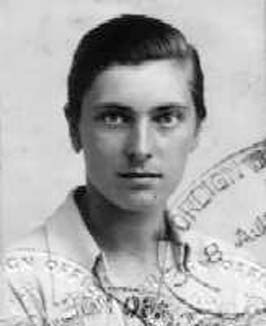
Sheila May Edmonds
 المؤلف:
Letter in The Times (September 2002)
المؤلف:
Letter in The Times (September 2002)
 المصدر:
Letter in The Times (September 2002)
المصدر:
Letter in The Times (September 2002)
 الجزء والصفحة:
...
الجزء والصفحة:
...
 8-1-2018
8-1-2018
 1629
1629
Born: 1 April 1916 in Kingston, Kent, England
Died: 2 September 2002 in Cambridge, England

Sheila Edmonds was the only child of Harold Montagu Edmonds (born in Camberwell, Surrey about 1884) who trained as a telephone engineer, and his wife, Florence Myra Lilley (born about 1887 in Stapleford, Nottinghamshire) who was a teacher.
At Wimbledon High School she excelled in mathematics and in 1935 she entered Newnham College, Cambridge, to study that subject. Newnham College had opened in 1880, although it grew from a house for women students which was established in 1871 after two years of planning. Although women could attend classes and take the examinations at the University of Cambridge in Edmonds' time, they could still not graduate with a degree which only became possible in 1947.
In Part II of the Mathematical Tripos Edmonds was a Wrangler (placed in the First Class) and in Part III, which she took in the following year, she received a distinction. She then began to undertake research under G H Hardy who, by this time, was nearing the end of his career. While undertaking research she spent a year at Westfield College,London, and another year at the University of Paris. Edmonds' doctoral thesis Some multiplication problems was completed in 1944.
Before her thesis was complete she had already published a number of papers which would form part of the work of her thesis. Two papers appeared in 1942: On the multiplication of series which are infinite in both directions was published in the Journal of the London Mathematical Society while On the Parseval formulae for Fourier transforms appeared in the Proceedings of the Cambridge Philosophical Society. We should say a little about the mathematics which these papers contain.
In the first of these papers Edmonds looks at the doubly infinite series ∑ an where the sum is over both positive and negative integers. The series is said to converge if the two series, one defined over the positive integers, the other defined over the negative integers, both converge. In this case the original series is said to have sum A = A' + A'' where A' and A'' are the sums over the positive and negative integers respectively. The product of two such sequences ∑ an and ∑ bn is defined to be ∑ cn where cn = ∑ ambn-m where the sum is again over all integers m, both positive and negative. Edmonds proves that even when ∑an converges and has sum A, ∑ bn converges and has sum B, and ∑ cn converges and has sum C, the relation C = AB need not hold.
In the second of the two papers Edmonds looks at conditions under which the integral from 0 to ∞ of the product of two functions f (x) and g(x) is equal to the integral from 0 to ∞ of the product of the cosine transforms of the two functions f (x) and g(x). Similar questions are investigated for the sine transforms rather than the cosine transforms. In a series of papers published over the following years Edmonds examined a whole variety of different conditions on the functions f and g which give the required equalities.
In 1957 Edmonds published Sums of powers of the natural numbers. In it she answered a question which arises very naturally. The formula
∑ n3 = (∑ n)2 (*)
has been known for over 1000 years (certainly al-Karaji knew it around 1000 AD). Edmonds asks if there are any other formulae of this type, in particular what formulae of the form
∑ Cnp = (∑ nq)2
are possible for C a constant and p, q non-negative integers? In Sums of powers of the natural numbers she showed that al-Karaji's formula (*) is the only one that exists.
The demands made on lecturers at Cambridge were great for they had to tutor students in all branches of pure and applied mathematics. Edmonds wished to give this aspect of her job 100% of her effort, so after 1957 she published no further papers. Teaching was a task in which she excelled [1]:-
... conveying in a characteristically understated manner a deep enthusiasm for her particular subject areas. Her patience, thoroughness and encouragement set a generation of women on the path to careers in mathematics and related subjects.
Edmonds made important contributions in addition to her teaching. She became Vice-Principal of Newnham College, Cambridge, in 1960 and she held this post until she retired in 1981. Other positions in which she served included ones in the Mathematical Association, and the Examination Syndicate, as well as serving several schools by sitting on the board of governers. She held positions of influence in Cambridge such as on the University Faculty Board of Mathematics which she chaired in 1975 and 1976.
As a person she is described in these terms in [1]:-
Sheila Edmonds was fundamentally a shy person but her reticent style concealed a great deal of warmth and real concern for her students, colleagues and friends. On formal occasions, she cut an impressive figure but without any hint of pomposity. After her retirement she was content to live quietly with her newly acquired dog until that was made impossible by the onset of Alzheimer's disease. She had no close relatives.
Professor John McCutcheon writes [2]:-
It is no exaggeration to say that the lectures of Sheila Edmonds were "wonderfully lucid and inspiring". I remember her as one of the very best teachers of my undergraduate career. She came across as a most sympathetic lecturer, clearly anxious to assist students in every way.
Articles:
- Letter in The Times (September 2002)
 الاكثر قراءة في 1915to1919
الاكثر قراءة في 1915to1919
 اخر الاخبار
اخر الاخبار
اخبار العتبة العباسية المقدسة


